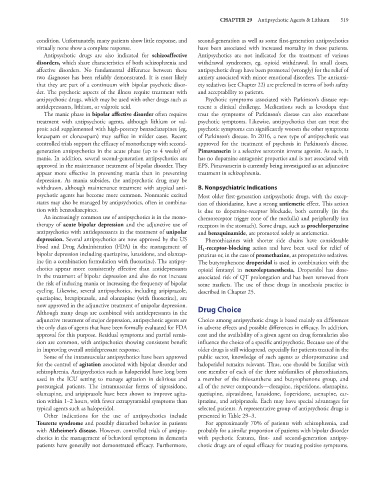Page 533 - Basic _ Clinical Pharmacology ( PDFDrive )
P. 533
CHAPTER 29 Antipsychotic Agents & Lithium 519
condition. Unfortunately, many patients show little response, and second-generation as well as some first-generation antipsychotics
virtually none show a complete response. have been associated with increased mortality in these patients.
Antipsychotic drugs are also indicated for schizoaffective Antipsychotics are not indicated for the treatment of various
disorders, which share characteristics of both schizophrenia and withdrawal syndromes, eg, opioid withdrawal. In small doses,
affective disorders. No fundamental difference between these antipsychotic drugs have been promoted (wrongly) for the relief of
two diagnoses has been reliably demonstrated. It is most likely anxiety associated with minor emotional disorders. The antianxi-
that they are part of a continuum with bipolar psychotic disor- ety sedatives (see Chapter 22) are preferred in terms of both safety
der. The psychotic aspects of the illness require treatment with and acceptability to patients.
antipsychotic drugs, which may be used with other drugs such as Psychotic symptoms associated with Parkinson’s disease rep-
antidepressants, lithium, or valproic acid. resent a clinical challenge. Medications such as levodopa that
The manic phase in bipolar affective disorder often requires treat the symptoms of Parkinson’s disease can also exacerbate
treatment with antipsychotic agents, although lithium or val- psychotic symptoms. Likewise, antipsychotics that can treat the
proic acid supplemented with high-potency benzodiazepines (eg, psychotic symptoms can significantly worsen the other symptoms
lorazepam or clonazepam) may suffice in milder cases. Recent of Parkinson’s disease. In 2016, a new type of antipsychotic was
controlled trials support the efficacy of monotherapy with second- approved for the treatment of psychosis in Parkinson’s disease.
generation antipsychotics in the acute phase (up to 4 weeks) of Pimavanserin is a selective serotonin inverse agonist. As such, it
mania. In addition, several second-generation antipsychotics are has no dopamine antagonist properties and is not associated with
approved in the maintenance treatment of bipolar disorder. They EPS. Pimavanserin is currently being investigated as an adjunctive
appear more effective in preventing mania than in preventing treatment in schizophrenia.
depression. As mania subsides, the antipsychotic drug may be
withdrawn, although maintenance treatment with atypical anti- B. Nonpsychiatric Indications
psychotic agents has become more common. Nonmanic excited Most older first-generation antipsychotic drugs, with the excep-
states may also be managed by antipsychotics, often in combina- tion of thioridazine, have a strong antiemetic effect. This action
tion with benzodiazepines. is due to dopamine-receptor blockade, both centrally (in the
An increasingly common use of antipsychotics is in the mono- chemoreceptor trigger zone of the medulla) and peripherally (on
therapy of acute bipolar depression and the adjunctive use of receptors in the stomach). Some drugs, such as prochlorperazine
antipsychotics with antidepressants in the treatment of unipolar and benzquinamide, are promoted solely as antiemetics.
depression. Several antipsychotics are now approved by the US Phenothiazines with shorter side chains have considerable
Food and Drug Administration (FDA) in the management of H -receptor-blocking action and have been used for relief of
1
bipolar depression including quetiapine, lurasidone, and olanzap- pruritus or, in the case of promethazine, as preoperative sedatives.
ine (in a combination formulation with fluoxetine). The antipsy- The butyrophenone droperidol is used in combination with the
chotics appear more consistently effective than antidepressants opioid fentanyl in neuroleptanesthesia. Droperidol has dose-
in the treatment of bipolar depression and also do not increase associated risk of QT prolongation and has been removed from
the risk of inducing mania or increasing the frequency of bipolar some markets. The use of these drugs in anesthesia practice is
cycling. Likewise, several antipsychotics, including aripiprazole, described in Chapter 25.
quetiapine, brexpiprazole, and olanzapine (with fluoxetine), are
now approved in the adjunctive treatment of unipolar depression. Drug Choice
Although many drugs are combined with antidepressants in the
adjunctive treatment of major depression, antipsychotic agents are Choice among antipsychotic drugs is based mainly on differences
the only class of agents that have been formally evaluated for FDA in adverse effects and possible differences in efficacy. In addition,
approval for this purpose. Residual symptoms and partial remis- cost and the availability of a given agent on drug formularies also
sion are common, with antipschotics showing consistent benefit influence the choice of a specific antipsychotic. Because use of the
in improving overall antidepressant response. older drugs is still widespread, especially for patients treated in the
Some of the intramuscular antipsychotics have been approved public sector, knowledge of such agents as chlorpromazine and
for the control of agitation associated with bipolar disorder and haloperidol remains relevant. Thus, one should be familiar with
schizophrenia. Antipsychotics such as haloperidol have long been one member of each of the three subfamilies of phenothiazines,
used in the ICU setting to manage agitation in delirious and a member of the thioxanthene and butyrophenone group, and
postsurgical patients. The intramuscular forms of ziprasidone, all of the newer compounds—clozapine, risperidone, olanzapine,
olanzapine, and aripiprazole have been shown to improve agita- quetiapine, ziprasidone, lurasidone, iloperidone, asenapine, car-
tion within 1–2 hours, with fewer extrapyramidal symptoms than iprazine, and aripiprazole. Each may have special advantages for
typical agents such as haloperidol. selected patients. A representative group of antipsychotic drugs is
Other indications for the use of antipsychotics include presented in Table 29–3.
Tourette syndrome and possibly disturbed behavior in patients For approximately 70% of patients with schizophrenia, and
with Alzheimer’s disease. However, controlled trials of antipsy- probably for a similar proportion of patients with bipolar disorder
chotics in the management of behavioral symptoms in dementia with psychotic features, first- and second-generation antipsy-
patients have generally not demonstrated efficacy. Furthermore, chotic drugs are of equal efficacy for treating positive symptoms.

